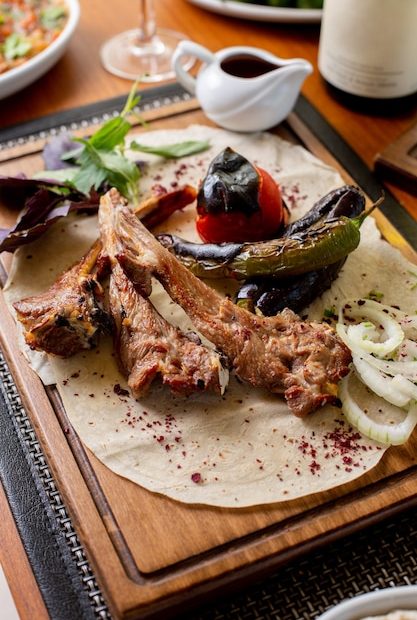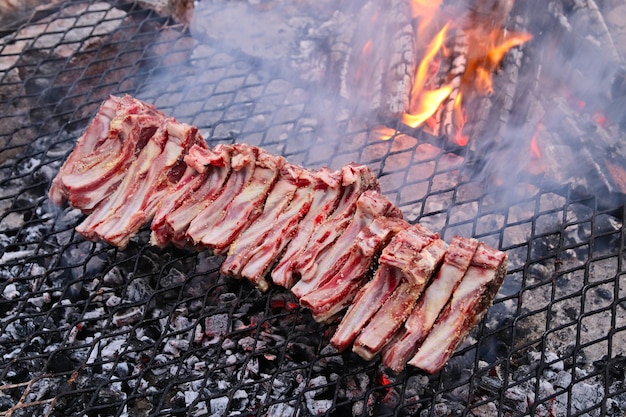Ribs Health and Quantity Considerations
Ribs are a popular dish in the UK, loved for their succulent meat and smoky flavors. Whether you’re enjoying them at a barbecue, restaurant, or cooking them at home, it’s important to consider both the health aspects and the quantity of ribs you consume. In this article, we will explore the factors to keep in mind when indulging in this delicious treat.
Health Benefits of Ribs
Ribs are primarily made from pork or beef, which both provide essential nutrients that contribute to a balanced diet. They are a good source of high-quality protein, which is vital for the growth, repair, and maintenance of our body tissues. Ribs also contain important vitamins and minerals such as iron, zinc, and B vitamins, which support various bodily functions.
However, it’s important to note that ribs are often prepared with marinades, sauces, or rubs that can be high in sugar and sodium, which may have negative health effects if consumed excessively. Moderation is key when it comes to enjoying ribs without compromising your overall well-being.
Quote:
“Ribs can be a part of a healthy diet when enjoyed in moderation and paired with nutritious side dishes.”
Quantity Considerations
While ribs are undeniably mouthwatering, it’s crucial to be mindful of portion sizes. Overindulging in ribs can lead to an excessive intake of calories, unhealthy fats, and sodium, which can contribute to weight gain, high blood pressure, and other health issues. Therefore, it’s advisable to enjoy ribs as part of a well-balanced meal that includes a variety of other nutrient-rich foods.
To maintain portion control, consider the following tips:
1. Choose Lean Cuts
Opt for lean cuts of ribs, such as baby back ribs or loin ribs. These cuts tend to have less fat than spare ribs, making them a healthier option.
2. Watch Your Serving Size
Keep in mind that a single serving of ribs is typically around 3-4 ribs. Be mindful of the portion you serve yourself or order at a restaurant to avoid going overboard.
3. Balance Your Meal
Accompany your ribs with healthy side dishes. Include a generous serving of vegetables, whole grains, and a fresh salad to create a well-rounded meal that provides a variety of nutrients.
How many ribs per person?
If you’re planning a barbecue or hosting a dinner party, one of the questions that often comes up is how many ribs to serve per person. Whether you’re grilling spare ribs, baby back ribs, or beef ribs, it’s important to have an idea of how much to prepare to ensure everyone is satisfied.
Types of Ribs
There are various types of ribs to choose from, each with its own characteristics and flavors:
- Spare Ribs: These larger, meatier ribs come from the side or belly of the pig. They are usually cut into individual portions.
- Baby Back Ribs: These smaller, leaner ribs come from the back of the pig. They are shorter in length and more tender.
- Beef Ribs: These larger, bone-in ribs are typically sold as single ribs or racks. They have a richer and more robust flavor than pork ribs.
Serving Size Guidelines
The number of ribs you should serve per person will depend on several factors, such as appetites, other sides or proteins being offered, and whether the ribs are the main dish or part of a larger meal. As a general guideline:
“For spare ribs: Plan on 4-5 ribs per person if they are the main course. If serving as part of a larger meal, 2-3 ribs per person should suffice.”
“For baby back ribs: Aim for 3-4 ribs per person if they are the main dish. For a larger spread, 1-2 ribs per person will usually be enough.”
“For beef ribs: One full rack of beef ribs generally serves 1-2 people.”
Accompaniments and Variations
When planning for a rib-centric meal, it’s important to consider the accompaniments and sides that will be served alongside the ribs. This will help determine the appropriate quantity of ribs per person. Popular sides for ribs include coleslaw, cornbread, baked beans, and potato salad.
Additionally, people’s appetites and dietary preferences can vary, so it’s always a good idea to have a variety of food options available to cater to everyone’s tastes.
.
Is pork the unhealthiest meat?
Pork is a widely consumed meat in the UK, but there has been ongoing debate about its health implications. While pork can be part of a balanced diet, it is important to consider certain factors when making dietary choices.
Nutritional Content
Pork is a good source of high-quality protein and contains essential nutrients such as iron, zinc, and B vitamins. However, it also has a relatively high fat content, including saturated fats, which can negatively impact heart health if consumed in excess.
Health Risks
Excessive consumption of pork has been linked to various health risks. The World Cancer Research Fund suggests that eating processed meats, including certain types of pork, can increase the risk of colorectal cancer. Additionally, the high fat content in pork can contribute to obesity and related health issues.
Choosing Healthier Options
To make healthier choices when consuming pork, opt for lean cuts and trim visible fat before cooking. Grilling or baking pork can help reduce the fat content further. It is also advisable to limit portion sizes and balance pork consumption with other protein sources, such as poultry, fish, and legumes.
The Importance of Moderation
It is essential to remember that no single food item determines overall health. Consuming pork in moderation, as part of a well-rounded diet, can be perfectly healthy. The key lies in maintaining a balanced approach to nutrition and incorporating a variety of foods to meet individual dietary needs.
“The key to a healthy diet is moderation and balance, regardless of the type of meat you choose to consume.” – Nutritionist Sarah Johnson
Here is an example of a table comparing the nutritional content per 100g of different meats:
| Meat | Protein (g) | Fat (g) | Saturated Fat (g) | Calories |
|---|---|---|---|---|
| Pork | 25 | 12 | 4.3 | 250 |
| Chicken | 31 | 3.6 | 1 | 165 |
| Beef | 26 | 20 | 8.9 | 250 |
Remember, a varied diet that includes a range of meats, as well as plant-based protein sources, is key to overall health and well-being.
Is BBQ Pork Ribs Healthy?
Barbecue pork ribs are a popular dish, especially during the summer months when people enjoy outdoor grilling. However, there is an ongoing debate about whether BBQ pork ribs are a healthy food choice. Let’s take a closer look at their nutritional value and consider some factors to make an informed decision.
Nutritional Profile of BBQ Pork Ribs
BBQ pork ribs are primarily made from pork meat, which contains essential nutrients like protein, vitamins, and minerals. However, they are also high in fat and calories. A 3-ounce serving of pork ribs typically contains around 250-300 calories, with the majority coming from fat.
Health Benefits:
- Pork ribs are a good source of protein, which is important for muscle growth and repair.
- They contain vitamins B6 and B12, which play a role in metabolism and nervous system function.
- Iron and zinc found in pork ribs contribute to red blood cell production and immune system health.
Potential Health Concerns
Fat and Calories: While pork ribs offer some nutritional benefits, their high fat and calorie content can be a concern. Most of the fat in pork ribs is saturated fat, which, when consumed in excess, may increase the risk of heart disease and obesity. Moderation is key.
“It’s important to balance indulgent foods like BBQ pork ribs with a predominantly healthy and balanced diet.”
Sodium Content: Another consideration is the sodium content in barbecue sauces and marinades often used with pork ribs. These sauces can be high in added sugars and sodium, which can negatively impact blood pressure and heart health. Choosing low-sodium options or making homemade sauces with less salt is a healthier choice.
How many ribs do you need for 2 people?
When it comes to cooking ribs, it’s important to know how much to buy, especially if you’re planning a meal for two. The number of ribs needed will depend on various factors such as the size of the ribs, the appetite of those eating, and the overall menu of your meal. Here are a few considerations to help you determine the right quantity of ribs for two people:
1. Type of Ribs
There are different types of ribs that you can choose from, including spare ribs, baby back ribs, and St. Louis-style ribs. Each type has a unique size and meatiness, which will affect the quantity you should buy. Generally, a full rack of ribs contains around 12-13 bones, but the actual weight may vary.
2. Portion Size
The portion size of the ribs will depend on how hungry you and your guest(s) are. If you both have hearty appetites, you may want to consider getting a full rack or more. However, if you prefer smaller portions or plan to serve other dishes alongside the ribs, half a rack per person might be sufficient.
3. Accompaniments
Consider what other dishes you’ll be serving with the ribs. If you’re planning an elaborate meal with several side dishes, you may need fewer ribs, as they will be part of a larger spread. On the other hand, if the ribs are the main feature of the meal, you may want to get a larger quantity to ensure everyone is satisfied.
There are no hard and fast rules when it comes to the exact number of ribs needed for two people. It’s always better to have a little extra rather than running out. Remember, it’s better to have leftovers than disappointed guests!
Tip: If you’re unsure about the quantity, ask your butcher for recommendations based on the type of ribs you prefer and the number of people you’ll be serving.
Additionally, if you’re looking for a visual guide, here’s an estimate of the number of ribs per person based on different types of ribs:
| Type of Ribs | Approximate Number of Ribs per Person |
|---|---|
| Spare Ribs | 4-5 ribs |
| Baby Back Ribs | 6-7 ribs |
| St. Louis-style Ribs | 5-6 ribs |
Ultimately, the quantity of ribs you need for two people will depend on personal preferences, appetite, and other dishes served. Use these guidelines as a starting point and adjust accordingly. Happy cooking!
Conclusion
BBQ pork ribs can be enjoyed as part of a balanced diet, but it’s essential to be mindful of portion sizes and the accompanying sauces. Including leaner cuts of meat, such as pork tenderloin, and opting for grilling methods that reduce fat, such as indirect heat, can make pork ribs a healthier choice. Pairing them with a variety of vegetables, whole grains, and limiting sugary sides will contribute to an overall nutritious meal.


